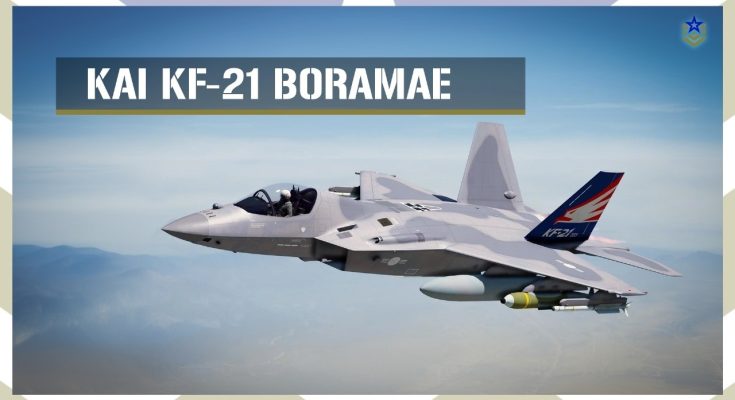The KF-21 Boramae, South Korea’s homegrown fifth-generation fighter jet, exhibits design similarities to the F-22 Raptor, a hallmark of stealth technology and air superiority. While the two aircraft are distinct, the resemblance is not accidental. Rather, it is the result of a combination of factors, including shared design principles, technological influences, and the goals behind developing a modern, advanced fighter jet. Here are some of the key reasons why the KF-21 shares design features with the F-22 Raptor:
1. Stealth Design Philosophy
One of the primary design objectives for both the KF-21 and F-22 is low radar visibility. Stealth technology is essential for modern fighter jets to survive in contested airspace. The F-22 was one of the pioneers of stealth design, with its sharp angles, flat surfaces, and smooth curves all contributing to a reduced radar cross-section (RCS). The KF-21’s design is clearly inspired by these principles. The aircraft features a similar “diamond” shape, with angled wings, canted tail surfaces, and a fuselage designed to deflect radar waves.
The KF-21 also employs a forward-swept wing configuration, which improves stealth by reducing radar reflections. These design choices, while distinct, are rooted in the same principles that were first popularized in the F-22. The intention is to create an aircraft that is difficult to detect by radar, ensuring superior survivability in combat situations.
2. Aerodynamic Efficiency and Agility
The F-22 Raptor is known for its incredible agility and maneuverability, which are vital for air superiority. It has a sleek, highly aerodynamic design that minimizes drag and allows for superior performance in both subsonic and supersonic flight. South Korea’s KF-21 seeks to achieve similar capabilities. The inclusion of sharp edges, smoothly integrated wings, and advanced canards all contribute to enhancing aerodynamic efficiency.
The KF-21 borrows some of the F-22’s aerodynamic principles to maximize lift and maneuverability. The aircraft’s design is intended to perform well in both high-speed intercepts and close-quarters dogfighting, where agility and control are paramount. While the KF-21 is not intended to be a direct rival to the F-22, the shared aerodynamic focus shows that both jets prioritize agility, high-speed performance, and maneuverability.
3. Technological Influence and Collaboration
South Korea has maintained a long-standing partnership with the United States, particularly in defense technology. The KF-21 Boramae’s development is heavily influenced by this relationship. While the KF-21 is a domestic design, South Korea has gained extensive access to U.S. military technology through programs like the F-35 acquisition and collaboration in various defense systems.
This collaboration has likely influenced the KF-21’s design, with the South Korean aerospace industry taking inspiration from U.S. fighters like the F-22. The U.S. and South Korea have shared expertise in avionics, radar systems, and stealth technology, which undoubtedly shaped the KF-21’s design. Additionally, the fact that the KF-21 borrows features like the airframe geometry of the F-22 suggests that South Korea was influenced by the tried-and-tested designs of American aircraft while seeking to develop its own unique fighter.
4. Strategic Goals for Air Superiority
The KF-21 was developed as a response to South Korea’s defense needs, particularly in countering threats from neighboring countries like North Korea and China. With an emphasis on air superiority, the KF-21 aims to rival other advanced aircraft, including the F-35 and F-22. The similarities in design between the KF-21 and F-22 reflect South Korea’s desire to build a fighter jet that can hold its own against the best in the world. By adopting key features from successful designs like the F-22, South Korea aimed to ensure that the Boramae would be effective in modern combat scenarios, leveraging stealth, speed, and agility.
5. Design Evolution and Industry Knowledge
South Korea’s aerospace industry, particularly through collaborations with Western countries and their own research and development, has made significant strides in creating advanced military aircraft. The design of the KF-21 represents an evolution of this knowledge. While South Korea does not have the same long history of building advanced fighters as the U.S., it has learned from existing, successful designs like the F-22. The influence of these designs is evident not as a direct copy but as a natural progression based on the principles of effective stealth, aerodynamics, and performance.
Conclusion
In summary, the similarities between the KF-21 Boramae and the F-22 Raptor are largely due to the shared design principles of stealth, high performance, and advanced aerodynamics. South Korea’s partnership with the U.S., the technical expertise gained from it, and the focus on building a modern, capable fighter have all contributed to the KF-21’s design. While the KF-21 is not a direct copy of the F-22, the influence is clear. The design shares many similarities because both aircraft seek to achieve similar objectives: superior stealth, agility, and performance in a highly contested airspace.



